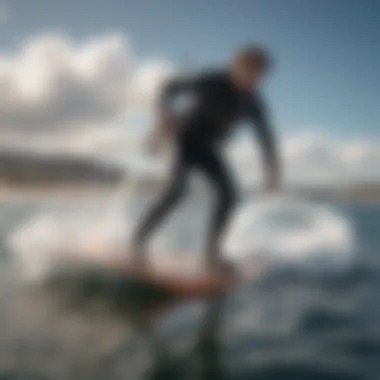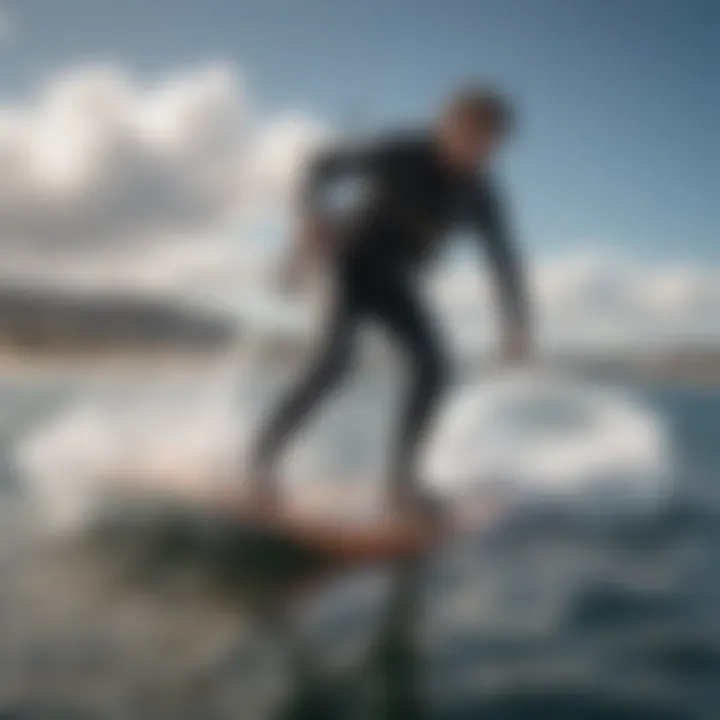The Evolution and Impact of Hydro Efoil Technology in Kitesurfing


Intro
The rapid advancement of hydro efoil technology has marked a significant turning point in the world of kitesurfing. This innovative approach combines the thrill of traditional kitesurfing with the unique advantages of hydrofoiling and electric propulsion. By elevating the rider above the water, hydro efoils provide a smoother and more efficient ride, opening up a new realm of possibilities for enthusiasts.
In this article, we will delve into the intricacies of hydro efoil technology. We will examine how hydrofoils operate, the mechanics behind electric propulsion, and the ways this technology transforms the rider's experience. We will also address the environmental implications associated with hydro efoiling, explore emerging trends, and provide practical considerations for users. This comprehensive analysis aims to serve as a resource for both novice kitesurfers and experienced practitioners, facilitating a deeper understanding of this cutting-edge technology.
Prelims to Hydro Efoil
Hydro efoil technology has become a significant advancement in the realm of kitesurfing. Understanding its role is essential for enthusiasts who want to explore new dimensions in their sport. This introduction aims to present a foundational overview. Hydro efoils allow riders to glide above water surfaces by utilizing lift generated from foils beneath the board. This enables a distinctly different experience from traditional kitesurfing, where the board remains submerged. As kitesurfing evolves, hydro efoils are not just a trend; they represent a paradigm shift.
The implementation of hydro efoil technology comes with various benefits. For instance, better efficiency during rides leads to longer sessions and reduced fatigue. Riders can experience smoother transitions, even in less favorable wind conditions. Moreover, hydro efoils generate less drag than traditional boards, promoting higher speeds over water. This new technology caters to a growing demand for innovation in extreme sports, which often thrives on the exploration of boundaries.
However, there are considerations to keep in mind. The learning curve associated with hydro efoils can be steep, especially for novices. Riders need to master the mechanics of lift and balance to navigate effectively. Additionally, the cost of equipment may be higher than what many are accustomed to in traditional kitesurfing setups. Hence, while they unlock new avenues for thrill-seeking, the investment in both time and resources cannot be overlooked.
Hydro efoils are reshaping the kitesurfing landscape. They offer experienced riders and newcomers a chance to connect with water in unique and exhilarating ways. As we delve deeper into the mechanics and history of hydrofoils, it becomes clearer how they have integrated into and transformed the kitesurfing experience.
Definition and Mechanics
A hydro efoil consists of a board equipped with a hydrofoil. The foils are submerged underwater with their wings angled to produce lift. As a rider gains speed, the lift becomes sufficient enough for the board to rise above the water. Understanding this mechanism is vital for maximizing performance and enjoyment.
Historical Context
The integration of hydrofoil technology into water sports is not completely new. Originally developed for boats, foils have found their way into various disciplines over the years. Kitesurfing began adopting this technology in the last decade, marking a notable evolution in rider capabilities. The combination of kitesurfing with hydrofoil systems reflects broader trends in extreme sports aimed at enhancing speed and efficiency.
The Technology Behind Hydrofoil Systems
The technology underpinning hydrofoil systems serves as a cornerstone in understanding how hydro efoils are transforming the kitesurfing experience. What makes hydrofoil technology relevant is its ability to enhance speed and efficiency while reducing drag through a unique design. This evolution allows riders to glide effortlessly above the water surface, giving them an extraordinary sense of freedom and control. It is essential to dissect this technology further to grasp its full impact on the sport and how it shapes rider experiences.
Components of a Hydro Efoil
Foils
Foils are critical elements of hydro efoil systems. They are shaped to take advantage of hydrodynamics in a way that allows the board to lift above the water. This particular property of foils is significant because it minimizes drag, enabling faster speeds and smoother rides. A key characteristic of foils is their design, typically with an elongated wing-like shape, which contributes to their performance in various water conditions.
The unique feature of foils is their material construction, which can vary from carbon fiber to aluminum. Carbon fiber, though more expensive, offers a better strength-to-weight ratio, thus enhancing overall performance. The advantages of this material include its light weight and rigidity, which provide a responsive ride. However, the high cost may deter some riders from purchasing top-tier foils.
Board Design
Board design plays a pivotal role in how effectively a hydro efoil operates. A hydro efoil board must cater not only to the propulsion system but also to rider comfort and control. A key characteristic of these boards is their length and width, which directly affect stability during rides. Wider boards tend to offer more stability, making them suitable for less experienced riders.
One unique feature in advanced board designs includes modular components that allow users to customize setups based on water conditions. This adaptability provides significant advantages, such as improved performance tailored to specific preferences. However, the complexity can be challenging for novice users and might require a learning curve.
Propulsion System
The propulsion system is another integral aspect of hydro efoil technology. Typically, electric motors power these systems, offering a clean and efficient alternative to traditional gas-powered propulsion in water sports. A defining characteristic of modern propulsion systems is their ability to provide thrust while remaining quiet and environmentally friendly.
The unique feature of these systems is their integration with advanced battery technology, which often includes lithium-ion batteries. The advantages of these batteries are their recharge speed and longevity. Conversely, the limited runtime under high throttle can be a disadvantage for some users, requiring careful planning regarding ride duration.


Mechanics of Lift and Drag
Understanding the mechanics of lift and drag is crucial to how hydro efoil systems operate. Lift is generated when water flows over the foils, creating an upward force sufficient to raise the board out of the water. This process occurs when the shape and angle of the foil interact effectively with the water flow.
Drag, on the other hand, is the opposing force that hinders movement. It can be categorized into two types: induced drag and viscous drag. Riders must navigate these dynamics, balancing lift and drag to optimize their performances. A deeper knowledge may lead to refined techniques, enhancing overall riding efficiency.
Electric Propulsion Systems
Electric propulsion systems are foundational to the advancement of hydro efoils in kitesurfing. They elevate the riding experience, allowing users to travel at higher speeds over water while reducing physical exertion. This technology is crucial not only for performance but also for safety and accessibility. Riders can enjoy kitesurfing without the need for strong winds, broadening when and where they can practice the sport. With ongoing advancements, the electric propulsion systems in hydro efoils promise further enhancements in performance and reliability.
Battery Technology
Battery technology has come a long way in recent years, significantly influencing electric propulsion in hydro efoils. Lithium-ion batteries dominate this space due to their lightweight and high energy density. This type of battery allows riders to achieve greater range and power without excessively increasing weight. Battery management systems ensure prolonged life cycles and consistent performance. The design of modern batteries enables faster charging times, making them more convenient for kitesurfers who want to maximize their time on the water. The choice of battery capacity impacts ride duration; therefore, understanding the balance between weight and power is essential for users.
Motor Efficiency
The efficiency of the motor is a critical aspect that determines the overall performance of hydro efoils. High-efficiency motors convert a greater percentage of electrical energy into mechanical energy, directly influencing the speed and responsiveness of the craft. Innovations in brushless motor technology provide lightweight options that do not compromise on power. Users benefit from longer sessions due to lower energy consumption, which translates to extended ride times on one battery charge. In addition, quieter operation of efficient motors enhances the experience, allowing for more immersive interactions with the natural environment. A good motor will integrate well with the battery system, further increasing the performance and usability of hydro efoils.
Electric propulsion systems in hydrofoiling transform the experience by offering higher speeds, better maneuverability, and accessibility for all skill levels.
As the technology progresses, both battery and motor innovations are crucial for the future of kitesurfing and hydro efoil technology.
User Experience and Performance
User experience and performance are critical facets within the context of hydro efoil technology in kitesurfing. This emerging technology is reshaping how enthusiasts engage with the water. It emphasizes not just the thrill of the ride, but how the technology enhances the overall experience. Understanding the interplay of various components can lead to better decision-making for both new and seasoned kitesurfers.
Riding Dynamics
Riding dynamics refers to the way a kitesurfer interacts with the board and the water. With hydro efoil systems, kitesurfers experience a sense of flying above the water, which significantly alters traditional riding dynamics. The lift generated by the foils allows for smoother transitions and less drag, enabling faster speeds and greater agility.
Riders often note that hydrofoiling feels more fluid than standard kitesurfing. The sensation of being lifted out of the water can be both exhilarating and disorienting at first. Riders must develop a unique rhythm to exploit the technology fully. Here are key aspects to consider:
- Elevation: The ability to ride above the water reduces resistance, leading to increased speeds.
- Maneuverability: Foils enable tighter turns and quicker responses, thus enhancing trick execution.
- Enhanced Stability: Despite initial learning curves, once mastered, riders find stability in varying conditions.
Integrating these dynamics into one's riding style requires practice. Understanding how to shift body weight and balance affects performance directly. Proper technique can lead to increased control and enjoyment.
Skill Development
Skill development is another vital aspect of user experience with hydro efoil technology. Mastering this innovative form of kitesurfing involves a combination of physical skill and mental adaptability. Riders transitioning from traditional kitesurfing to hydrofoiling must recalibrate their methods.
Key elements of skill development include:
- Balance and Control: Developing core strength and balance is essential. Many riders engage in cross-training activities to enhance these skills.
- Board Awareness: Learning to anticipate how the board reacts under various conditions improves responsiveness.
- Environmental Adaptation: Understanding how wind and water conditions affect hydrofoil performance aids in navigating challenges.
The learning curve may initially feel steep, but gradual practice yields significant rewards. Each successful ride builds confidence, prompting riders to experiment with advanced maneuvers.
"The transition to hydrofoil kitesurfing redefines the experience; it teaches patience and adaptability in every ride."


Ultimately, enhancing user experience through improved performance and skill development fosters a deeper connection between the rider and the surf. It also encourages a supportive community as riders share insights and techniques, thus aiding collective advancement within the sport.
Impact on Kitesurfing Culture
The advent of hydro efoil technology has initiated significant transformations within kitesurfing culture. This shift is marked by new community dynamics, perceptions of kitesurfing, and the blending of traditional practices with modern advancements. Understanding these elements is crucial, as they shape the way practitioners engage with the sport and each other.
Community Reception
The introduction of hydro efoils has sparked diverse reactions among kitesurfing enthusiasts. Some celebrate the technology for its innovation and potential to enhance the riding experience. Riders appreciate the ability to glide above the water, enabling smoother rides even in low wind conditions. This change has attracted a new demographic of enthusiasts who are eager to experience the unique sensations offered by hydro efoiling.
However, there are skeptics. Traditional kitesurfers often view hydrofoiling as a departure from the core essence of the sport. The feeling of harnessing wind power directly is central to kitesurfing culture. For some, hydro efoiling may feel like an artificial experience, detracting from the thrill associated with traditional kitesurfing. Consequently, discussions on forums like Reddit and Facebook reflect varying opinions, often highlighting a divide between purists and those open to integrating new technologies.
"While hydrofoils are providing thrilling new experiences, they may challenge what it means to truly kitesurf," a user remarked on a popular kitesurfing forum.
Integration with Traditional Kitesurfing
The fusion of hydro efoils with traditional kitesurfing is both an opportunity and a challenge. Many riders are finding ways to blend techniques from both disciplines. Experienced kitesurfers are adapting their skills to maneuver hydrofoils, creating a new riding style that prioritizes fluidity and efficiency.
Moreover, instructional courses and community events are emerging to bridge the gap. Kitesurfing schools are incorporating hydro efoil training into their curriculums. This encourages traditional riders to explore the new technology, promoting an environment of learning and adaptation.
Yet, this integration is not without its tensions. As hydro efoils gain popularity, there are concerns about safety and the preservation of kitesurfing spots. Increased traffic in popular areas can lead to overcrowding and competition for space on the water. To mitigate these issues, communities are working on guidelines to ensure that both traditional kitesurfers and hydrofoilers can coexist respectfully and safely.
In summary, the impact of hydro efoil technology on kitesurfing culture is profound. It reshapes community interactions, influences perceptions, and blends traditional practices with modern innovations. This evolution is essential for understanding how kitesurfing may continue to develop in the years to come.
Environmental Considerations
The rise of hydro efoil technology in kitesurfing not only offers thrilling recreational experiences but also presents important environmental considerations. As the popularity of this technology grows, it is essential to analyze its impact on sustainability and marine ecosystems. Understanding these factors becomes vital, especially as kitesurfers seek to enjoy their sport in an eco-friendly manner. This section will explore the sustainability of electric power and the potential effects on marine life.
Sustainability of Electric Power
Hydro efoil systems rely on electric propulsion, which raises questions about their environmental sustainability compared to traditional wind-powered methods. The core benefit is the reduction of reliance on fossil fuels. Electric motors can potentially operate on renewable energy sources, such as solar or wind, when integrated with suitable battery technology. This becomes especially relevant for kitesurfers who wish to minimize their carbon footprint.
However, the true sustainability depends on the lifecycle of the batteries utilized in these systems. Lithium-ion batteries are commonly used; their extraction and disposal can carry significant environmental risks. It’s crucial for manufacturers and users to engage in practices that ensure the responsible sourcing and recycling of these batteries.
"The transition to electric power in hydro efoiling has the potential to significantly decrease the sport’s overall environmental impact, although care must be taken with battery lifecycle management."
Impact on Marine Life
Another essential factor is the impact of hydro efoil technology on marine ecosystems. The noise generated by electric propulsion systems can affect local wildlife, including fish, dolphins, and other marine creatures. Noise pollution is a critical area of concern, as it may alter the behavior of aquatic life. Kitesurfers using hydro efoils should be aware of their surroundings and avoid areas known to be habitats for sensitive marine species.
Additionally, the physical presence of efoils raises concerns about potential disruptions to aquatic ecosystems. While efoils operate at higher speeds, they also require careful positioning to avoid shallow waters or sensitive habitats such as coral reefs.
Emerging Trends in Hydro Efoil Technology
Emerging trends in hydro efoil technology are pivotal for the future of kitesurfing. With continuous advancements in both engineering and user experience, these trends are not only reshaping the sport but also addressing various challenges facing enthusiasts and manufacturers. Understanding these trends provides valuable insight into how hydro efoils will evolve, enhancing performance and accessibility for kitesurfers.
Advancements in Design


The progression in design is one of the most notable trends in hydro efoil technology. Modern hydrofoils are being crafted with materials that maximize strength while minimizing weight. Carbon fiber and advanced composites have become standard in the construction of hydrofoils, ensuring durability without sacrificing performance. Furthermore, designs are increasingly optimizing the geometry of the foils to enhance both lift and drag dynamics, allowing riders to achieve greater speeds with less effort.
There is also a movement towards customizable designs. Many manufacturers are offering modular systems, enabling riders to mix and match parts to suit their personal riding styles. This personalization leads to a more engaging and enjoyable experience, allowing kitesurfers to easily tailor their equipment for specific conditions.
In addition, innovations in hydrodynamics play a crucial role in the evolution of hydro efoil technology. Foil shapes are adapting based on extensive testing and rider feedback, which leads to better performance in diverse conditions. Riders have noticed these improvements, as new designs offer a smoother ride and increased maneuverability, which are essential for both novice and expert kitesurfers.
Market Growth
The market for hydro efoil technology is rapidly expanding. As the popularity of this sport increases, more entrants are appearing in the field, ranging from established kiteboarding companies to startups dedicated solely to hydro efoil design. This influx into the market drives both competition and innovation, which ultimately benefits consumers.
Recent data indicates that the demand for electric hydrofoils has surged, offering a glimpse into lucrative market opportunities. As more people seek eco-friendly alternatives, the sustainable aspect of electric propulsion aligns with current consumer values. Kitesurfing enthusiasts are increasingly looking for gear that showcases environmental responsibility, which further augments the growth of the market.
Moreover, several events and competitions specifically featuring hydro efoil kitesurfing are becoming prevalent. These events not only boost visibility for brands but also cultivate a community around the sport. As more participating enthusiasts witness the evolution in techniques and technology firsthand, they are inspired to join in, contributing to the burgeoning market.
"The growth in the hydro efoil sector is indicative of a shift in kitesurfing culture itself, as more athletes and novices alike embrace the benefits of this innovative technology."
The future holds much promise in the realm of hydro efoil technology, with ongoing advancements in design and an expanding market ensuring that the kitesurfing landscape remains vibrant and engaging.
Practical Considerations for Users
In the rapidly evolving world of hydro efoil kitesurfing, understanding the practical considerations for users becomes essential. The complexities of operating and maintaining these advanced boards can pose challenges, but with the right knowledge and preparation, users can enhance their experience significantly.
Maintenance and Care
Proper maintenance of a hydro efoil system is crucial for longevity and optimal performance. Regular inspections and timely care can prevent malfunctions that might compromise safety or enjoyment while riding. Key aspects of maintenance include:
- Regular Cleaning: After each use, it is important to rinse the hydrofoil and components with fresh water to prevent corrosion and buildup of saltwater residues. Dry all parts thoroughly before storing.
- Battery Care: Li-ion batteries power most hydro efoils. Users should follow specific charging guidelines, avoid overheating, and store the battery in a cool, dry place.
- Foil and Board Inspections: Check for any signs of damage on the foils and the board itself. Look for cracks, chips, or other signs that may affect performance. Address any issues immediately to avoid further damage.
- Propulsion System Check: Ensure that the motor and propeller are free of debris. Regular checks will help in maintaining efficiency during rides.
Implementing a maintenance routine can not only prolong the equipment's life but also enhance performance, allowing users to fully enjoy the unique experience that hydrofoils offer.
Safety Guidelines
Safety should never be overlooked, especially in sports as dynamic as kitesurfing. Hydro efoils introduce new variables, and understanding safety measures is vital to reduce risks. Here are some fundamental safety guidelines for users:
- Wear Proper Gear: Always utilize a suitable life jacket and helmet when riding. These protective items can safeguard against unexpected falls or collisions.
- Familiarize with Technology: Take time to understand the controls and workings of your hydro efoil. Knowledge of throttle response and turning mechanics is crucial.
- Choose Safe Locations: Select riding areas wisely. Avoid crowded spots where interaction with other water users can increase dangers. Check the weather and tidal conditions before heading out.
- Buddy System: Whenever possible, ride with a partner or inform someone onshore about your plans. Having an additional person can be beneficial in case of emergencies.
- Emergency Procedure Preparedness: Know how to handle potential failures, such as the propulsion system stopping unexpectedly. Practice re-entry techniques to maintain buoyancy if you fall.
"Always prioritize safety to enhance enjoyable experiences on the water. Hydro efoils demand respect and understanding of their unique technology."
Following these practical considerations not only enhances user experience but reinforces safety, allowing for enjoyable and responsible kitesurfing with hydro efoil technology.
Future of Hydro Efoil in Kitesurfing
The future of hydro efoil technology in kitesurfing is pivotal to understanding the ongoing evolution of this sport. As hydrofoils become more integrated into kitesurfing, several aspects need to be considered. This includes the anticipated innovations in design and functionality, the increasing accessibility for riders, and the potential impacts on performance. Furthermore, the convergence of technology and rider experience stands to reshape how kitesurfing is practiced and perceived.
Potential Innovations
The realm of hydro efoils is ripe for innovation. Upcoming advancements are being driven by both materials science and electrical engineering. We may witness lighter, more durable materials being used in foil construction, further enhancing lift and reducing drag. The use of composites and advanced alloys can result in equipment that is both robust and nimble.
In addition, the evolution of electric propulsion systems is crucial. The integration of more efficient batteries will provide longer ride times and improved power management. Future models may also incorporate smart technology, allowing riders to monitor performance metrics in real time. Such innovation could take the form of app-based interfaces that track speed, distance, and even environmental conditions.
Long-term Usage Trends
As the hydro efoil technology advances, long-term usage trends indicate significant shifts in rider demographics and practices. Adoption rates are likely to increase, making hydrofoiling more mainstream among kitesurfers. As more brands enter the market, competition will drive innovations that cater to diverse skill levels and preferences.
Additionally, the community surrounding kitesurfing may evolve. More riders will begin to integrate hydrofoiling into their kitesurfing sessions. This blending of traditional kitesurfing with hydrofoiling could lead to the development of new riding styles and techniques. Therefore, the cultural aspects of the sport will naturally shift as riders embrace learning curves associated with these new technologies.







